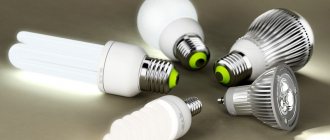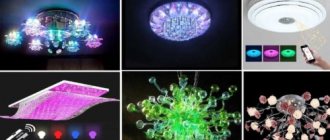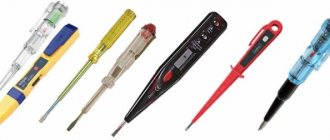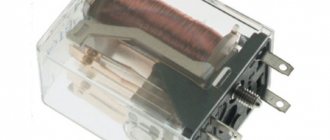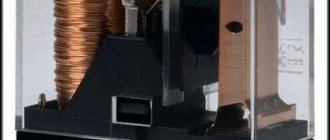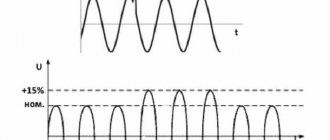06/24/201606/25/2016 master
Today, you can choose a wide variety of light sources to illuminate your home: from old and proven incandescent lamps to modern and economical LED light bulbs. Any lamps, be it chandeliers or sconces, can use any model that fits the base as a light source.
During operation, light bulbs tend to heat up. Some heat up more than others, which determines one of the main selection criteria. In many situations, when choosing light bulbs for a chandelier and other types of lamps, people do not think about this component. But sometimes this approach can lead to negative consequences, especially in the situation of suspended ceilings. Our article will tell you about light bulbs that do not heat up during their work and why you should definitely think about this if you have suspended ceilings.
What lamps are best to use in an apartment?
Light-emitting diode (LED) lamps are the most modern and reliable light sources. They last up to 25 times longer than incandescent lamps, and consume almost 8 times less electricity. They light up instantly, practically do not heat up and do not flicker. The quality of light is as close to natural as possible.
Interesting materials:
How to install msvcp120 DLL program? How to install Team Viewer? How to set the default Word program? How to install firmware on PS4? How to set dropdown list in Excel? How to install a browser extension? How to install the AdBlock extension in Google Chrome? How to install sliding doors on a suspended ceiling? How to install Realtek High Definition Audio Driver? How to install crack for gta 4 Steam?
Where does thermal energy come from and where is it spent?
When an electric current passes through a conductor, thermal energy is released, which is calculated according to the Joule-Lenz law. According to the equation, excess heat is proportional to resistance. But when heated, the resistance value of metals increases, which leads to increased heating. Incandescent lamps are equipped with a metal base and a heat-resistant glass bulb, which are responsible for removing excess thermal energy. It should be taken into account that the life of the light source is determined not by the temperature of the housing, but by the inhomogeneities that arise in the filament.
A standard light bulb with a tungsten filament emits light over a wide range of wavelengths; the human eye detects only part of the interval. The main flow occurs in the infrared region and is perceived as heat. The efficiency of products, calculated from the ratio of the expended power to the received radiation in the visible range, does not exceed 15%. But the filament converts up to 99% of the supplied energy into radiation.
The use of other principles for the formation of luminous flux makes it possible to reduce losses due to infrared radiation and increase the efficiency of light bulbs.
A few words about the design
LED lamps are a complex electronic device, the design of which is divided into several parts:
- Diffuser. It is a glass or plastic flask that serves to uniformly disperse the light flux.
- The chips are light-emitting diodes.
- The printed circuit board is the platform on which the LEDs are mounted. Made from material with high thermal conductivity.
- The radiator is a structure made of material with high thermal conductivity. Serves to remove heat.
- The driver is an LED power supply, used to convert the alternating voltage of a 220-volt electrical network into the power necessary for the normal operation of the LEDs.
- The socket is an important element that serves to connect the light bulb to the lamp socket.
Let's start with the ceilings
Stretch ceilings today have become quite popular and common in our homes and apartments. In terms of prevalence, they are comparable only to plasterboard structures.
Note! A special feature of any suspended ceilings is their base or stretch fabric. It consists of a special material (PVC film), which, when heated with a special construction hairdryer, is capable of taking a tense position along the entire area of the ceiling.
Polyvinyl chloride, which is the basis of such a film, does not tolerate heat quite well after its installation. Therefore, here the need arises for the correct selection of a light source for chandeliers and spotlights, which will later be installed on structures for indoor lighting. Incorrect selection of light bulbs or incorrect placement of chandeliers (bronze, crystal, etc.) can lead to damage to suspended ceilings. Using light bulbs that get very hot, you can easily damage the fragile structure of polyvinyl chloride.
Note! Irreversible destruction of the polyvinyl chloride layer occurs when the temperature reaches 110-120°C.
To summarize, such damage is possible in the following situations:
- incorrectly selected light source. This is the main reason why the beautiful glossy surface of stretch ceilings most often deteriorates. In a situation with such a ceiling, experts recommend using only energy-saving light bulbs;
Note! Energy-saving light sources today can be used in any lamps: from chandeliers (glass, crystal, bronze, etc.) to spotlights. As a rule, these two types of lighting fixtures are used when installing suspended ceilings.
- installation of chandeliers (bronze, crystal, wood, etc.) too close to the tension surface. In order to minimize the negative impact of a heated light bulb on the ceiling structure, chandeliers are usually used in pendant varieties. In this case, you can reduce the harm by increasing the distance between the light source and the PVC film;
Note! The option of installing pendant chandeliers is not always appropriate, since the room may have low ceilings. In such a situation, you have to use spotlights built into the ceiling or ceiling chandeliers. But this does not solve the problem.
Chandelier on a suspended ceiling
- installation of lampshades in such a way that they shine upward onto the covering of suspended ceilings. If the lampshades are placed in this way, and not downwards, then the heat flow will concentrate on the film, and not dissipate in the space of the room. This again leads to the appearance of defects on the canvas.
The best and easiest option to implement, which will avoid damage to the polyvinyl chloride film of the ceiling structure, is the use of energy-saving light sources.
It shines and does not heat: What types of energy-saving light bulbs are there and how to choose them
It shines and does not heat: What types of energy-saving light bulbs are there and how to choose them
https://zbulvar.ru/archive/svetit-i-ne-greet-kakie-byvayut-energosberegayushie-lampochki-i-kak-ih-vybirat/
The recent initiative of the Ministry of Energy to ban the production of incandescent lamps with a power greater than 50 kW can be viewed in different ways. Some support it, others consider it premature. But one way or another, what is the alternative? How do the light bulbs that replaced incandescent lamps differ from each other, and how to choose them? Consultants of the electrical goods store on Leskova Street, Andrey Maly and Vlad Zhakitov, helped ZB answer these questions.
According to the buyer's assessment, incandescent lamps are laid out on one shelf in a tall display cabinet. On the second there are halogen ones in the form of sockets, whisks and nozzles. The remaining six shelves are occupied by LED lamps of various shapes and modifications. — This corresponds to the current situation: today not only incandescent lamps can be considered obsolete, but also energy-saving lamps of the first generation - compact fluorescent lamps (CFLs) in the form of a spiral. Halogen lamps are also being used less and less,” says Andrey Maly. — LEDs are taking their place: they have advantages over all previous types of lamps.
KPL versus Ilyich's light bulb About ten to twelve years ago, compact fluorescent lamps, twisted like a snail, appeared on sale, and seemed like a breakthrough. They consume four to five times less energy and last many times longer than an incandescent lamp. In fact, it was not difficult to defeat Ilyich’s light bulb. “This is more of a heating device than a lighting one: only 15% of the energy is spent on lighting, the rest is spent on heating,” says Vlad Zhakitov. — The estimated life of an incandescent lamp is 6-11 months. However, the price of such a lamp in stores is 25-40 rubles. A snail lamp costs more: 60-70 rubles. But it is designed for five to eight years of work. But there is also a minus: mercury vapor is pumped inside the glass tube. “Such lamps are bought less and less often,” comments Andrey Maly. — Sooner or later, the question arises of where to throw it away: you can’t just throw it in a trash container. This is dangerous for the environment.
Halogen: no mercury But a halogen light bulb is a bulb with pairs of halogen elements - bromine or iodine - and the same filament as in Ilyich’s light bulb. Essentially, this is an improved incandescent lamp. Halogen lamps are not as efficient as compact fluorescent lamps. Compared to Ilyich light bulbs, energy consumption is reduced only by half, and the service life increases by 2-2.5 times. But the main feature of halogen light bulbs is that, thanks to the variety of shapes and designs, they can be installed where no others can be installed: built-in lighting, ceilings, cabinets, floors, panels. The price of halogen lamps is comparable to CPL - 60-70 rubles.
LED: 27 years of glow The LED light bulb is shaped like an incandescent lamp: the same pear. But the filling in it is different: not a tungsten filament, but a semiconductor crystal. “The energy efficiency of LEDs is the same as that of fluorescent lamps: lighting costs are reduced by four to five times,” says Vlad Zhakitov. - And the service life of the light bulb is much longer. The packaging says 30 thousand hours, that’s 27 years of glow, but the calculated readings are even longer - up to 50 thousand hours. Another advantage of LED bulbs is that they do not heat up, no matter how long they are turned on: the surface of the lamp always remains cold. Marina MAKEEVA
PLEASE NOTE: The LED will pay for itself in a year Nikolai Protopopov, lighting engineering expert: - Advice from previous years: in the hall, where the light is on all day, screw in fluorescent bulbs, in a table lamp - an LED, and in a night light you can use an incandescent light bulb - are outdated today. Now, in all cases, it is better to install LEDs of the appropriate type, brightness, and color. Their only disadvantage is their high price compared to CPLs, halogens, and especially incandescent lamps: 150-250 rubles. But in 8-12 months, LEDs will pay for themselves and allow you to save energy for one and a half to two decades. Pay attention to the manufacturer and price. If an LED lamp costs less than 150 rubles, then there is a high probability that it was made “on the knee”.
Advantages of a gentle temperature regime
Advantages of low-temperature light sources have a number of advantages:
- reducing the heating temperature of lamp housings and wire insulation in the area adjacent to the contacts;
- the possibility of installing lampshades in decorative coatings not designed for exposure to elevated temperatures;
- reducing energy consumption by reducing infrared radiation;
- an increase in the light flux visible to the human eye.
Main conclusions
LED lamps heat up during operation, like all other types of lamps. However, the degree of heating is significantly lower than that of other designs. It depends on various factors:
- lamp power;
- quality of crystals;
- lamp operating mode.
There are no designs that do not heat up at all during operation. The efficiency of any lamp clearly demonstrates the relationship between the luminous flux and the dissipation of applied energy, which is dissipated in the form of heat. LED devices usually heat up to 60-70°, which does not pose a fire hazard and does not damage the stretch ceiling fabric. Express your opinion about heating LED lamps in the comments.
Previous
LEDsHow to properly solder SMD LEDs
Next
LEDsHow to properly connect LED strips to each other

